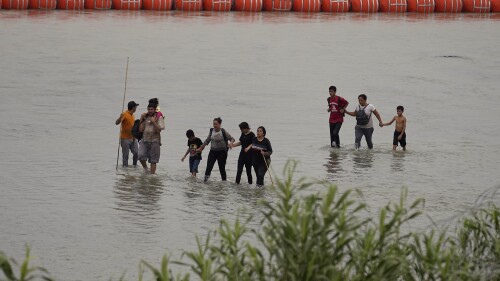Putting a floating barrier in the Rio Grande to stop migrants is new. The idea isn’t.
AUSTIN, Texas (AP) — In the final months of the Trump administration, a new plan to seal off the United States’ southern border started gaining steam: a floating water barrier to discourage migrants from trying to cross from Mexico.
The idea never materialized. But three years later, Texas Republican Gov. Greg Abbott has put it into action.
The state installed a floating barrier of bright orange, wrecking ball-sized buoys on the Rio Grande this month, stretching roughly the length of three soccer fields.
Other news Climate change leaves fingerprints on July heat waves around the globe, study says
Climate change’s sweaty fingerprints are all over the July heat waves gripping much of the globe. A new study finds these intense and deadly hot spells in the American Southwest and Southern Europe could not have occurred without it.
Climate change leaves fingerprints on July heat waves around the globe, study says
Climate change’s sweaty fingerprints are all over the July heat waves gripping much of the globe. A new study finds these intense and deadly hot spells in the American Southwest and Southern Europe could not have occurred without it.
 Man gets 12 years in prison for a shooting at a Texas school that injured 3 when he was a student
A 19-year-old has been sentenced to 12 years in prison after being found guilty of attempted capital murder in a 2021 shooting at a Dallas-area high school that wounded two other students and a teacher.
Man gets 12 years in prison for a shooting at a Texas school that injured 3 when he was a student
A 19-year-old has been sentenced to 12 years in prison after being found guilty of attempted capital murder in a 2021 shooting at a Dallas-area high school that wounded two other students and a teacher.
 Biden administration sues Texas governor over Rio Grande buoy barrier that’s meant to stop migrants
The lawsuit filed Monday asks a court to force Texas to remove a line of bright orange, wrecking ball-sized buoys that the Biden administration says raises humanitarian and environmental concerns.
Biden administration sues Texas governor over Rio Grande buoy barrier that’s meant to stop migrants
The lawsuit filed Monday asks a court to force Texas to remove a line of bright orange, wrecking ball-sized buoys that the Biden administration says raises humanitarian and environmental concerns.
 Texas is using disaster declarations to install buoys and razor wire on the US-Mexico border
Texas Gov. Greg Abbott has escalated measures to keep migrants from entering the US. The Republican is pushing legal boundaries along the border with Mexico to install razor wire and deploy buoys on the Rio Grande.
Texas is using disaster declarations to install buoys and razor wire on the US-Mexico border
Texas Gov. Greg Abbott has escalated measures to keep migrants from entering the US. The Republican is pushing legal boundaries along the border with Mexico to install razor wire and deploy buoys on the Rio Grande.
It is an untested strategy of deterring migrants along the U.S. border that is already fortified in wide sections by high steel fencing and razor wire. The rollout of the buoys on the Rio Grande has thrust Texas into a new standoff with the Biden administration over immigration on the state’s 1,200-mile (1,930-kilometer) border with Mexico.
The Justice Department has asked a federal court to order Texas to remove the buoys, saying the water barrier poses humanitarian and environmental concerns along the international boundary. Abbott has waved off the lawsuit as he is cheered on by conservative allies who are eager for cases that would empower states to take on more aggressive immigration measures.
That legal battle comes as President Joe Biden’s administration defends a new asylum rule in court. A federal judge Tuesday blocked the policy that the administration sees as a way of controlling the southern border while maintaining avenues for migrants to pursue valid asylum claims. The judge’s order won’t take effect for at least two weeks.
Here’s what to know about the river barrier:
‘The Water Wall’
Like other pieces of Abbott’s multibillion-dollar border mission known as Operation Lone Star, the buoys pick up where former President Donald Trump left off.
In 2020, Mark Morgan was the acting commissioner of U.S. Customs and Border Protection. He told The Associated Press on Tuesday that he approved plans to deploy the same water barrier on the Rio Grande that Texas is now using.
That August, the Army Corps of Engineers posted a solicitation for a “buoy barrier system” that would “mitigate the ability of swimmers to climb” over or under it.
Morgan called it the “water wall.”
“It was really designed to be a stopgap to utilize in high-flow areas where we didn’t have a physical structure in place,” Morgan said.
Spokespersons for CBP did not immediately address questions Tuesday about the 2020 plans. The federal International Boundary and Water Commission, whose jurisdiction includes boundary demarcation and overseeing U.S.-Mexico treaties, said it didn’t get a heads-up from Texas about the state’s floating barrier.
Experts have raised concerns of the buoys changing the river’s flow or of objects getting caught in them. Morgan, who is now a visiting fellow with the conservative Heritage Foundation, said environmental reviews under Trump raised issues with the barrier but said he could not recall specifics.
“Just like the physical wall itself, right, there are a variety of things you can do to accommodate that,” he said.
‘Flouted Federal Law’
It is unclear how quickly a federal judge in Texas will rule on the Biden administration’s lawsuit.
Until then, roughly 1,000-foot (305-meter) of barrier will remain on a potion of the Rio Grande that separates Eagle Pass, Texas and Piedras Negras, Mexico. The Mexican government has also raised concerns about the barrier, saying it may violate 1944 and 1970 treaties on boundaries and water.
The Biden administration’s lawsuit accuses Texas of violating the federal Rivers and Harbor Act. Vanita Gupta, associate attorney general, said Texas “flouted federal law” and risks damaging U.S. foreign policy.
The buoys are the latest escalation in Texas’ border mission that also includes National Guard patrols, jails that house migrants arrested on trespassing charges and busloads of asylum-seekers sent to Democratic-led cities across the U.S.
‘See You in Court, Mr. President’
Abbott has tried to position America’s biggest red state as the foremost antagonist to the Biden administration’s border policies. Last year, Abbott easily won a third term in a campaign that focused on border policies.
In a letter to Biden this week, Abbott said the state was acting within its rights to protects its borders
“Texas will see you in court, Mr. President,” he wrote.
He said it was the Biden administration that was putting putting migrants at risk by not doing more to dissuade them from making the journey to the U.S.
Disclaimer: The copyright of this article belongs to the original author. Reposting this article is solely for the purpose of information dissemination and does not constitute any investment advice. If there is any infringement, please contact us immediately. We will make corrections or deletions as necessary. Thank you.






